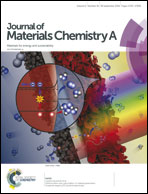Synthesis of cesium-doped ZnO nanoparticles as an electron extraction layer for efficient PbS colloidal quantum dot solar cells†
Abstract
Colloidal quantum dot (CQD) solar cells based on lead sulfide (PbS) have attracted tremendous interest due to their strong near-infrared absorption and air-stable photovoltaic performance. To improve the electron transporting layer in PbS CQD solar cells, we have invented a new synthesis protocol to achieve uniformly Cs-doped ZnO nanoparticles (NPs) with finely controlled doping concentrations. An optimal amount of Cs doping can effectively passivate the ZnO defects, resulting in excellent transparency, ideal energy levels, high nanoparticle crystallinity, large conductivity, and smooth film morphology. These Cs-doped ZnO NPs can be used as the low-temperature solution-processed electron transporting layer in PbS CQD solar cells. Consequently, the PbS CQD solar cells adopting 5% Cs-doped ZnO achieved the best PCE of 10.43%, while the devices using pristine ZnO NPs only exhibit a PCE of 9.20%, which can be attributed to the reduced interfacial recombination and improved charge extraction at the PbS/ZnO interface. In addition, the devices using Cs–ZnO show extremely stable performance over three months storage under ambient conditions. Moreover, compared to reported Cs-doping of ZnO using sol–gel processing, our doped ZnO NPs demonstrate superior properties without high-temperature annealing, which makes them excellent candidates for use as the ETL in future flexible photovoltaics.



 Please wait while we load your content...
Please wait while we load your content...